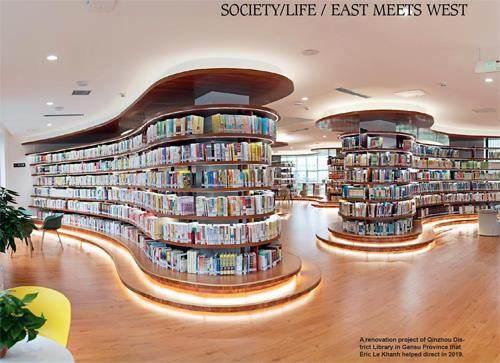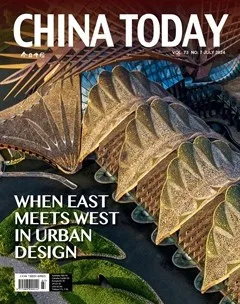Building up Relationship Through Architecture
LIU CHANG

IN 2021, archaeologists announced the results of theirexcavation in Fengtai District in southwest Beijing.They included ruins of the wall of an ancient cityknown as Zhongdu, the capital of the Jin Dynasty(1115-1234) for six decades before it fell to the Mongols.
Subsequently, it was decided that a Jin Zhongdu CityWall Ruins Park would be built on the site, next to Beijingsnew Lize financial district, as part of the capitalcitys urban renewal drive. French architect and urbanplanner ?ric Le Khanh was on the design team. “The protectionproject is part of a larger urban park and culturalfacility that shows how history can be integrated into thecentral business district in a modern city,” Khanh toldChina Today . In 2022, the project won the OutstandingPlanning and Design Award from the Tianjin Landscape Garden Society.
During his two decades of residence in China, Khanhhas been involved in many stimulating projects for bigcities and also in transportation, landscaping, and urbannetwork services. Currently, his priority is set on smallprojects.
His China journey started in 2003 with a month-longbusiness trip. After that, he approached several Chineseconstruction companies and got a job offer from the EastChina Architectural Design and Research Institute. “I acceptedit with pleasure and curiosity,” he says.
Encounter with China
Khanh had been working as anarchitect in Paris for more than a decadebefore coming to China, so thisjob was a new professional experiencefor him. In July 2003, he began to workin the Shanghai-based architecturefirm and was struck by the scale of construction projects and rapid urban development in China.
At that time, there were fewer foreigners in China. “Althoughthere was a lot of international communicationin China, it was mostly superficial,” he recalls. “Culturaldifferences may have been an important reason.” Khanhrealized that the biggest challenge in communication wasnot mastering the Chinese language, but understanding theChinese culture. With thousands of years of history, the richand complex Chinese culture reflects the countrys vast sizeand geographical diversity. As a result, he worked hard tolearn more about China.
However, cultural and languagedifferences were no barrier to love.In 2010, Khanh met his wife at anart exhibition. Their mutual appreciationand shared values broughtthem together. At present, the happily-married couple live in Beijingwith their six-year-old son.
Chinese Cosmology and Urbanization
In 2016, Khanh joined the Beijing Institute of ArchitecturalDesign, becoming the firms first French expert. Hefound that the Chinese cosmology played a unique role inurban design in China.
“In the case of the central axis of Beijing (a nearlyeight-km imaginary line that connects the four importantplaces of the city and monuments and other structuresand heaven representing the power of the state),the relationship between the emperor and heaven guidedthe development of all buildings around the ForbiddenCity. It illustrated the central position and importance ofthe emperor, while also symbolizing the connection betweenheaven and earth. Under the tenets of Taoism, therelationship between humans and nature is very strong.Through this concept, China has built many harmonioustraditional cities that are well integrated into the landscape,”he says.
In Khanhs view, the rapid urbanization that began inthe 1980s broke this harmony to some extent. However,in recent years, with the adjustment and optimization ofChinas urban planning and development policies, ecology,the protection of heritage and pragmatism have beenput at the core of urban development. This also coincideswith Khanhs design concepts. He believes that it is importantto protect the cultural heritage in urban development.His urban renewal concept also has elements ofsci-fi – building a city on top of a city.
Sino-French Cooperation
Another significant project he took part in was theSino-French Ecological Park in Chengdu, capital of southwestChinas Sichuan Province. From 2017 to 2018, ashead of the French company AREP in Shanghai, he wasresponsible for coordinating the planning and implementationof the ecological park. “The international communityneeds to look at the future from the perspective ofsustainable development,” he says. In Khanhs view, protectingand appropriately developing the environment iscrucial for future generations and urban residents. “(Participatingin the project) has strengthened my professionalskills in managing and coordinating Sino-Frenchcooperation, which has benefited from the diverse culturalbackgrounds of my colleagues,” he says.
At present, Khanh is working on a series of renovationprojects in Sujiatuo, a town in Beijings Haidian District.A base of Sino-French cultural exchange, Sujiatuo was the home of two Frenchmen. The French poet, diplomat, andNobel laureate in literature Saint-John Perse (1887-1975)had his holiday villa there. The other was Jean Jér?meAugustin Bussière (1870-1960), a doctor who providedselfless assistance to the Chinese during the War of Resistanceagainst Japanese Aggression (1931-1945).
Projects Khanh is working on include the constructionof a hotel, a department store, a cultural building, and aSino-French art center to commemorate the friendshipbetween the two countries.
Khanh was also on the design teams for many projectsacross China, such as the Yangliuqing National Grand CanalCulture Park in Tianjin, and a residential communityin Chengdu. The French architect is a visiting professorin the School of Architecture of Tianjin University, wherehe instructs senior students in urban and architecturalrenovation projects.
This year marks the 60th anniversary of the establishmentof diplomatic relations between China and France. “Itis a milestone year because it confirms the close and deepties between the two countries,” he says. It is the strongkinship between the two countries that drives him to exploreand contribute more to China-France cooperation.

